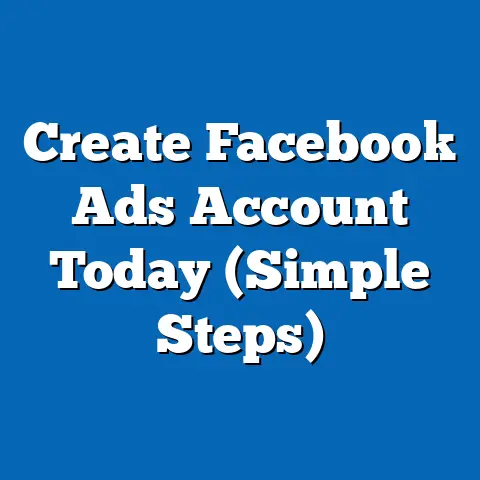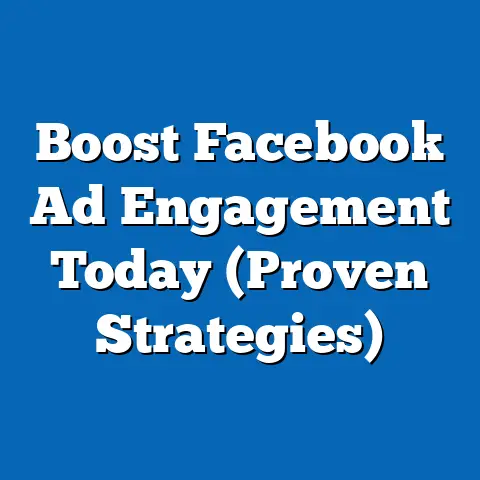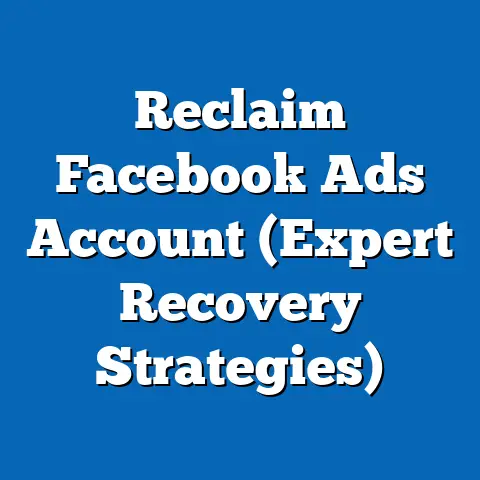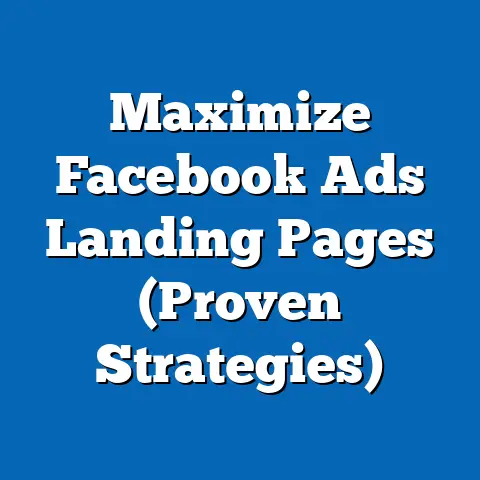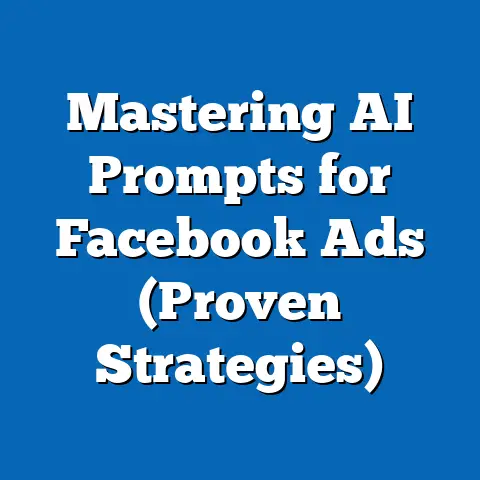Boost Brand with Facebook Ads in SF (Proven Strategies)
In today’s digital age, standing out from the crowd requires a strategic and targeted approach to marketing. As someone who has navigated the ever-evolving landscape of digital advertising for years, I can tell you that Facebook ads remain a powerhouse for businesses, especially in a dynamic market like San Francisco. San Francisco, with its tech-savvy residents and thriving startup culture, presents unique opportunities for brands to connect with their target audience through social media. I’ve seen firsthand how businesses can leverage Facebook to not only enhance their visibility but also drive meaningful engagement and conversions. With a substantial user base and sophisticated targeting capabilities, Facebook offers unparalleled potential for local brands to reach potential customers effectively. In fact, recent statistics show that San Francisco businesses are increasingly allocating a significant portion of their marketing budgets to Facebook ads, recognizing the platform’s ability to deliver measurable results. Let’s dive into some proven strategies that can help you boost your brand with Facebook ads in the heart of innovation – San Francisco.
1. Understanding the San Francisco Market
San Francisco isn’t just another city; it’s a unique ecosystem of innovation, culture, and forward-thinking individuals. Understanding the nuances of this market is crucial for crafting Facebook ad campaigns that resonate with the local audience. From my experience, I’ve learned that what works in other cities might not necessarily work here. The San Francisco consumer base is characterized by a diverse blend of demographics, preferences, and behaviors. The city is a melting pot of cultures, with a significant presence of tech professionals, entrepreneurs, and young creatives. This demographic tends to be highly educated, digitally savvy, and socially conscious, influencing their purchasing decisions and brand preferences.
The local culture in San Francisco is heavily influenced by the tech industry, which promotes a culture of innovation, sustainability, and community engagement. San Franciscans are often early adopters of new technologies and trends, making them receptive to innovative advertising approaches. Additionally, the city’s strong emphasis on sustainability and social responsibility means that brands need to align their values with those of their target audience to gain traction. I’ve noticed that campaigns highlighting eco-friendly practices, ethical sourcing, and community involvement tend to perform exceptionally well.
The startup ecosystem in San Francisco also plays a significant role in shaping marketing strategies. With a plethora of startups vying for attention, competition is fierce, and brands need to be creative and strategic to stand out. This environment fosters a culture of experimentation and data-driven decision-making, which is essential for optimizing Facebook ad campaigns. In my work, I’ve found that startups often benefit from focusing on niche markets and leveraging targeted advertising to reach specific segments of the population.
To effectively target the San Francisco market, it’s essential to integrate these factors into your Facebook ad campaigns. This means crafting ads that reflect the local culture, resonate with the values of the target audience, and leverage innovative approaches to capture their attention. For instance, an ad campaign promoting a sustainable product could highlight its eco-friendly features and its positive impact on the community. Similarly, a campaign targeting tech professionals could focus on the product’s innovative features and its ability to solve specific problems.
Key Takeaway: San Francisco’s market requires a nuanced approach. Understand the demographics, values, and culture to tailor your Facebook ads effectively.
2. Crafting Compelling Ads
Creating Facebook ads that capture attention and drive engagement requires a blend of creativity, strategic messaging, and compelling visuals. I’ve spent countless hours perfecting ad designs, and I’ve learned that the most successful ads are those that resonate with the target audience on an emotional level.
Visuals play a crucial role in grabbing the attention of users as they scroll through their Facebook feeds. High-quality images and videos that are relevant to the product or service being advertised are essential. I recommend using eye-catching visuals that immediately convey the value proposition and evoke curiosity. For example, a local restaurant could use mouth-watering images of their signature dishes to entice users to click through and make a reservation.
Messaging is equally important. The ad copy should be concise, engaging, and tailored to the target audience. It should clearly communicate the benefits of the product or service and address the specific needs or pain points of the audience. I’ve found that using storytelling techniques, humor, or emotional appeal can significantly increase engagement rates. For instance, a local fitness studio could share a success story of a client who transformed their life through their program.
Calls-to-action (CTAs) are the final piece of the puzzle. A compelling CTA should clearly instruct users on what action to take next, whether it’s visiting a website, making a purchase, or signing up for a newsletter. I advise using strong action verbs and creating a sense of urgency to encourage immediate action. Examples of effective CTAs include “Shop Now,” “Learn More,” “Sign Up Today,” and “Get a Free Quote.”
A/B testing different ad formats is a crucial step in optimizing Facebook ad campaigns. A/B testing involves creating multiple versions of an ad with slight variations and testing them against each other to see which performs best. This can involve testing different visuals, messaging, CTAs, or targeting options. I always stress the importance of continuously testing and refining ad campaigns to discover what resonates best with the target audience.
For example, a local clothing boutique could A/B test two different ad visuals: one featuring a model wearing the clothing and another featuring a close-up of the fabric and design. They could also test different messaging, such as “Shop Our New Collection” versus “Elevate Your Style.” By analyzing the results of these tests, they can identify which ad format drives the most clicks and conversions.
Key Takeaway: Compelling Facebook ads require a blend of engaging visuals, strategic messaging, and clear calls-to-action. A/B testing is essential for optimizing ad performance and discovering what resonates best with the target audience.
3. Targeting the Right Audience
Facebook’s advanced targeting capabilities are a game-changer for businesses looking to reach their desired audience in San Francisco. From my experience, I’ve seen how precise targeting can significantly improve the effectiveness of ad campaigns and maximize ROI.
Defining your target demographics, interests, and behaviors is the first step in leveraging Facebook’s targeting capabilities. This involves identifying the specific characteristics of your ideal customer, such as age, gender, location, education, income, interests, and online behavior. I recommend conducting thorough market research and analyzing customer data to gain a deep understanding of your target audience.
Creating custom audiences is another powerful targeting strategy. Custom audiences allow you to target specific groups of people based on their existing relationship with your business. This can include targeting website visitors, email subscribers, or customers who have interacted with your Facebook page. I’ve found that custom audiences are particularly effective for retargeting campaigns, which involve showing ads to people who have previously shown interest in your products or services.
Lookalike audiences are a valuable tool for expanding your reach and finding new customers who are similar to your existing ones. Lookalike audiences allow you to create a new audience based on the characteristics of your custom audience. I often use lookalike audiences to target people who share similar demographics, interests, and behaviors with my best customers.
Retargeting strategies are essential for driving conversions and maximizing ROI. Retargeting involves showing ads to people who have previously visited your website or interacted with your business on Facebook. I’ve seen firsthand how retargeting can be incredibly effective for reminding people about your products or services and encouraging them to take action.
For example, a local bookstore could create a custom audience of people who have visited their website and browsed specific book categories. They could then create a retargeting campaign showing ads for those specific books to encourage those visitors to make a purchase. Additionally, they could create a lookalike audience based on their existing customer base to target new customers who share similar interests and reading habits.
Key Takeaway: Facebook’s advanced targeting capabilities allow businesses to reach their desired audience with precision. Defining target demographics, creating custom audiences, leveraging lookalike audiences, and implementing retargeting strategies are essential for maximizing ad performance.
4. Measuring Success and ROI
Measuring the success of your Facebook ad campaigns is crucial for understanding what’s working and what’s not. I’ve always been a firm believer in data-driven decision-making, and I’ve found that tracking key performance indicators (KPIs) is essential for optimizing campaigns and maximizing ROI.
Click-through rates (CTR) are a key metric for measuring the effectiveness of your ad creative and targeting. CTR measures the percentage of people who see your ad and click on it. A high CTR indicates that your ad is relevant and engaging to your target audience. I recommend monitoring CTR closely and making adjustments to your ad creative or targeting if you see low numbers.
Conversion rates measure the percentage of people who take a desired action after clicking on your ad, such as making a purchase, signing up for a newsletter, or filling out a form. A high conversion rate indicates that your ad is effectively driving people to take the desired action. I always emphasize the importance of optimizing your landing page and ensuring a seamless user experience to improve conversion rates.
Return on ad spend (ROAS) is a critical metric for measuring the overall profitability of your Facebook ad campaigns. ROAS measures the amount of revenue generated for every dollar spent on advertising. A high ROAS indicates that your ad campaigns are generating a significant return on investment. I advise businesses to track ROAS closely and make adjustments to their campaigns to improve profitability.
Setting up tracking mechanisms is essential for accurately measuring the performance of your Facebook ad campaigns. This involves installing the Facebook Pixel on your website and setting up conversion tracking to track specific actions taken by users after clicking on your ad. I’ve seen how proper tracking can provide valuable insights into campaign performance and inform optimization decisions.
Analyzing data to gain insights into campaign performance is the final step in the measurement process. This involves using Facebook Analytics and other tools to analyze the data collected and identify trends, patterns, and areas for improvement. I recommend conducting regular performance reviews and making adjustments to your campaigns based on the insights gained.
For example, a local e-commerce store could track CTR to measure the effectiveness of their ad creative, conversion rates to measure the effectiveness of their landing page, and ROAS to measure the overall profitability of their campaigns. By analyzing this data, they can identify which ads are driving the most sales, which landing pages are converting the best, and which campaigns are generating the highest return on investment.
Key Takeaway: Measuring success and ROI is essential for optimizing Facebook ad campaigns. Tracking KPIs such as CTR, conversion rates, and ROAS, setting up tracking mechanisms, and analyzing data to gain insights are crucial for maximizing ad performance and profitability.
5. Future Trends and Innovations in Facebook Advertising
The world of Facebook advertising is constantly evolving, and staying ahead of the curve is essential for maintaining a competitive edge. In the context of San Francisco, with its fast-paced tech industry and early adopter culture, embracing future trends and innovations is even more critical.
The rise of video content is one of the most significant trends in Facebook advertising. Video ads are highly engaging and effective at capturing the attention of users as they scroll through their feeds. I anticipate that video content will continue to dominate the Facebook advertising landscape in the coming years.
Augmented reality (AR) ads are another emerging trend that has the potential to revolutionize the way businesses advertise on Facebook. AR ads allow users to interact with virtual objects in their real-world environment, creating immersive and engaging experiences. I’ve seen firsthand how AR ads can be particularly effective for showcasing products and services in a unique and memorable way.
The integration of artificial intelligence (AI) in ad targeting and personalization is also poised to transform Facebook advertising. AI can be used to analyze vast amounts of data and identify patterns and insights that can be used to improve ad targeting and personalization. I believe that AI will play an increasingly important role in helping businesses reach the right audience with the right message at the right time.
I always encourage readers to stay informed about the latest trends and innovations in Facebook advertising and to experiment with new approaches to see what works best for their business. This may involve attending industry conferences, reading industry publications, and following thought leaders in the field.
For example, a local furniture store could experiment with AR ads that allow users to virtually place furniture in their homes before making a purchase. They could also leverage AI to personalize ad messaging based on users’ browsing history and purchase behavior.
Key Takeaway: Staying ahead of the curve is essential for maintaining a competitive edge in Facebook advertising. Embracing future trends and innovations such as video content, augmented reality ads, and the integration of AI in ad targeting and personalization can help businesses reach their target audience more effectively and drive better results.
Conclusion
Facebook ads are a powerful tool for boosting brand presence and driving business growth in the dynamic San Francisco market. By understanding the unique characteristics of the local audience, crafting compelling ads, targeting the right people, measuring success, and embracing future trends, businesses can unlock the full potential of Facebook advertising.
I urge local businesses to adopt these proven strategies and to continuously experiment, optimize, and refine their campaigns to achieve the best possible results. The potential for growth and success through effective advertising in the vibrant SF market is immense. By leveraging the power of Facebook, businesses can enhance their visibility, engage with the community, and drive meaningful conversions that fuel their bottom line. So, take the plunge, embrace the challenge, and watch your brand soar in the heart of innovation.

